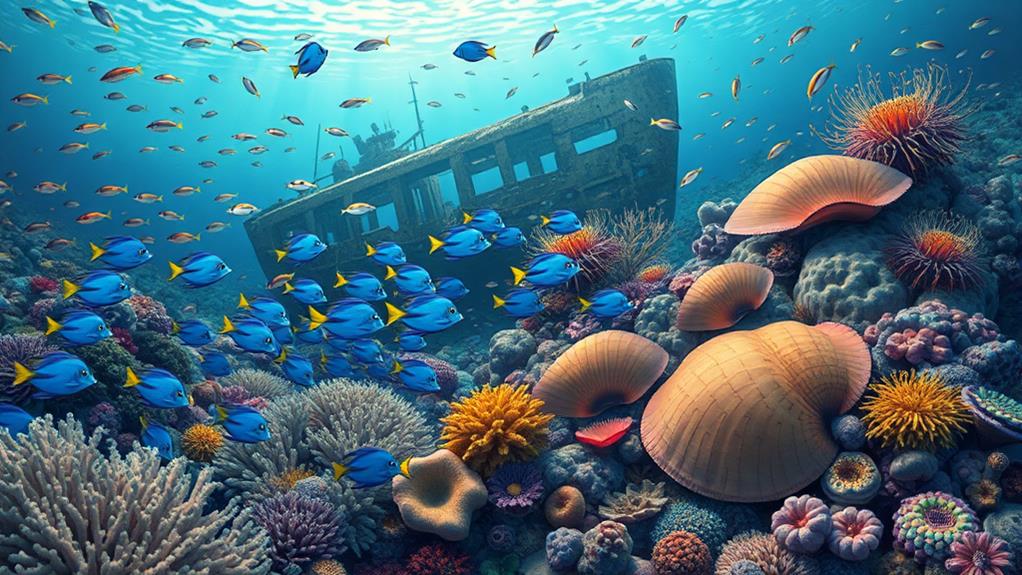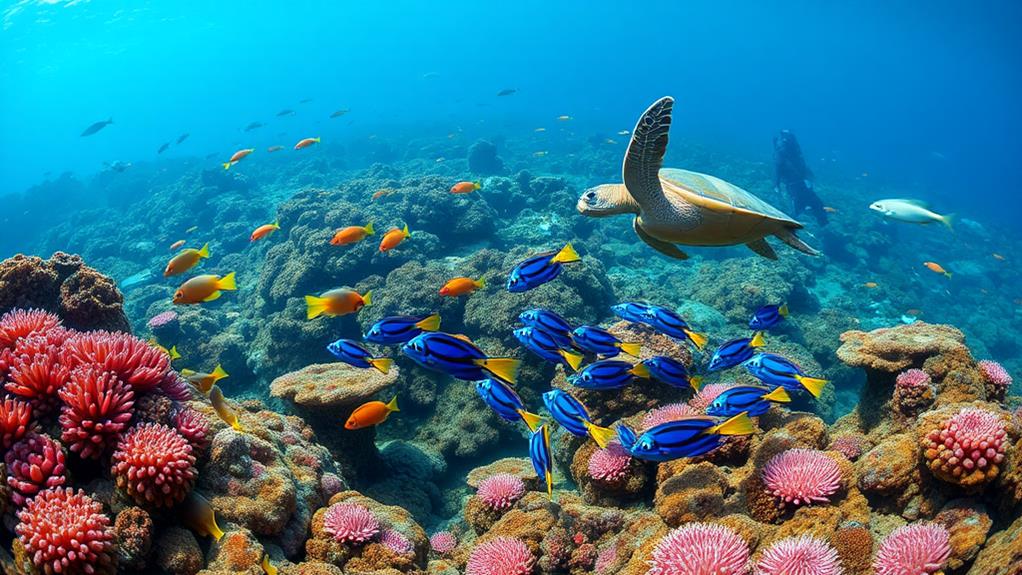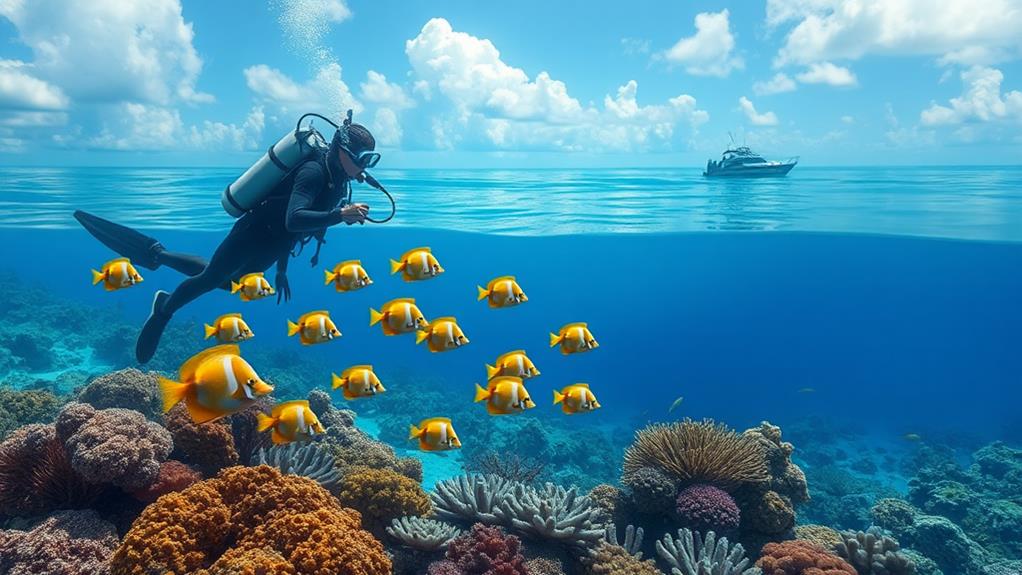Apo Reef Natural Park is a marine sanctuary with diverse coral reefs, spanning 34 square kilometers of coral reef habitat. The park is located in the heart of the Coral Triangle, which is known as the global center of marine biodiversity. Within its waters, visitors can expect to see abundant fish and coral species, making it a popular destination for snorkeling and diving enthusiasts. The park also plays a crucial role in the conservation of marine life and is protected under Philippine law to ensure the preservation of its delicate ecosystem.
This habitat is home to over 2,228 species of reef fish and approximately 605 types of reef-building corals, making it one of the most biodiverse marine sanctuaries on the planet.
The park's unique atoll-like structure enhances biodiversity, creating an ideal environment for diverse coral formations and ecosystems.
Critically endangered species can be found within the protected area, along with nesting grounds for endangered sea turtles.
A no-take zone has been established to allow overfished species to recover.
This protected area is crucial for the conservation of marine life, and its significance extends beyond what is immediately visible.
Apo Reef's Ecological Significance

Apo Reef Natural Park is a biodiversity hotspot, boasting an impressive array of marine life that thrives within its 34 square kilometers of coral reef habitat. This is due to the coexistence of approximately 285 species of marine life, including critically endangered species like thresher and hammerhead sharks, which call this contiguous coral reef system home.
The shallow lagoon's ideal conditions support a variety of coral formations and marine ecosystems, such as the surrounding mangrove forests that serve as crucial nurseries and spawning grounds for many coastal and marine species. This enhances the ecological health of the area.
The submerged platform structure's unique northern and southern atoll-like reefs, separated by a 30-meter deep channel, contribute to the park's diverse underwater ecosystems. As a result, Apo Reef Natural Park has earned its reputation as a marine sanctuary, providing a habitat for an incredible array of species to coexist and thrive.
Preserving coral reefs and their associated ecosystems is crucial for future generations, as demonstrated by Apo Reef Natural Park's ecological significance.
Conservation History and Efforts
Apo Reef Natural Park's conservation history began in 1980 with its designation as a Marine Park through Presidential Proclamation No. 1801, aiming to protect its rich marine biodiversity.
This marked the beginning of a series of initiatives to safeguard the reef ecosystem.
The local government of Sablayan established a Tourism Zone and Marine Reserve in 1983, which promoted sustainable tourism and conservation efforts.
This designation allowed for the management of tourism activities while protecting the marine environment.
In 1996, Apo Reef was proclaimed a protected Natural Park under Presidential Proclamation No. 868, further solidifying its conservation status.
This designation enhanced the protection of the reef ecosystem and its biodiversity.
Apo Reef was listed for consideration as a UNESCO World Heritage site in 2006, highlighting its global significance in marine biodiversity.
This recognition emphasized the importance of conserving the reef's unique ecosystem.
Ongoing initiatives, such as the Conservation of Priority Protected Areas Project (CPPAP), focus on sustainable management practices to enhance the protection and sustainability of the reef ecosystem.
These efforts involve local communities in the conservation process, ensuring their participation and cooperation in protecting the reef.
Biodiversity and Marine Life

Apo Reef Natural Park: A Hub of Marine Biodiversity
Located at the heart of the Coral Triangle, Apo Reef Natural Park is renowned for its unparalleled richness of marine biodiversity. This underwater world is teeming with life, and as a visitor, you'll have the opportunity to explore it.
Diverse Marine Life
Apo Reef is home to an astonishing array of marine life, including:
- Over 2,228 species of reef fish, making it a hub for marine biodiversity.
- Approximately 605 types of reef-building corals, which form the foundation of the reef's complex ecosystems.
- Critically endangered species, such as thresher and hammerhead sharks, as well as nesting grounds for endangered sea turtle species like the green sea turtle (Chelonia mydas).
Ecosystems and Conservation
The diverse ecosystems within Apo Reef include various coral formations and habitats that contribute to the overall ecological balance and health of the marine environment.
As a no-take zone, Apo Reef provides a safe haven for overfished species to recover and thrive, ensuring the long-term conservation of its unique marine habitats.
Visitor Information and Activities
Plan Your Visit to Apo Reef Natural Park
To ensure a smooth and enjoyable trip to Apo Reef Natural Park, careful planning is essential. The park is located approximately 33 km away from Sablayan, Occidental Mindoro, which is the nearest town.
Verify entrance fees and regulations before your visit to avoid any unexpected surprises.
Recreational Activities
Apo Reef Natural Park offers various recreational activities, including scuba diving, snorkeling, kayaking, and bird watching. These activities attract marine enthusiasts throughout the year.
The park provides educational programs and guided tours to enhance your experience and raise awareness about marine conservation efforts. By participating in these programs, you'll gain a deeper appreciation for the park's biodiversity and marine life.
Accommodations and Rules
Plan ahead for accommodations, as facilities may vary. To ensure a comfortable stay, book your accommodations in advance.
Remember to respect the park's rules and regulations to help preserve this incredible marine sanctuary.
What makes Apo Reef Natural Park different from Tubbataha Reefs Natural Park in terms of marine conservation and biodiversity?
Apo Reef Natural Park and Tubbataha Reefs Natural Park both boast rich marine biodiversity, but they differ in terms of conservation efforts. Apo Reef focuses on coral reef restoration and protection, while tubbataha reefs natural park has a strong emphasis on enforcing strict regulations to preserve its pristine ecosystem.
What Makes Mount Apo and Apo Reef Must-Visit Destinations for Nature Enthusiasts?
Mount Apo and Apo Reef are perfect destinations for nature enthusiasts seeking breathtaking landscapes and unique biodiversity. Whether it’s hiking mount apo in the philippines to conquer its majestic peaks or exploring the vibrant marine life at Apo Reef, these spots promise unforgettable adventures for those who crave natural beauty and outdoor excitement.
Management and Sustainability

Apo Reef Natural Park's Collaborative Management
Apo Reef Natural Park has been managed by the Department of Environment and Natural Resources (DENR) in collaboration with local government units and non-governmental organizations since its establishment.
This collaborative approach has led to the development of a robust management framework, which includes the Protected Area Management Office (PAMO) and the Management Board (PAMB). These bodies oversee the enforcement of regulations and sustainable practices, ensuring the park's conservation goals are met.
Key Aspects of Management and Sustainability
The park operates as a no-take zone, prohibiting fishing and other extractive activities to protect marine biodiversity and promote ecological resilience.
Eco-tourism and sustainable livelihoods are promoted, fostering the transition of local communities from traditional fishing to tourism-related activities to minimize ecological impact.
Effective management strategies have been recognized, earning the park the Platinum Award in 2022 for conservation excellence.
Frequently Asked Questions
Is Apo Reef Worth It?
Apo Reef is worth visiting because it offers an unparalleled snorkeling and diving experience as a hub of marine biodiversity. This unique ecosystem is home to a vast array of marine life, including over 400 species of fish and 100 species of coral.
Supporting conservation efforts is crucial, as it contributes to the reef's coral health. By visiting Apo Reef, you'll be supporting initiatives that protect this incredible natural wonder.
Stunning underwater photography opportunities await at Apo Reef, with its vibrant coral and diverse marine life. To capture these moments, be sure to bring your camera or phone with a waterproof case.
Minimizing your eco-tourism impact is essential. To do this, follow visitor guidelines, which include not touching or standing on the coral, not feeding the fish, and not littering.
What Is the Apo Reef Natural Park Known For?
Apo Reef Natural Park is renowned for its exceptional coral biodiversity, making it a top destination for an unforgettable diving experience. This unique ecosystem is home to a vast array of coral species, with over 400 species recorded, including brain corals, fan corals, and staghorn corals.
The park's ecological significance is unmatched, with its conservation efforts earning it the prestigious Platinum Award in 2022. As a hub for research opportunities, environmental education, and habitat protection, Apo Reef provides a platform for scientists, students, and conservationists to study and protect the marine ecosystem.
The park offers breathtaking underwater photography spots, with its crystal-clear waters and vibrant marine life providing a perfect backdrop for capturing stunning images.
However, it's essential to be aware of the tourism impact and take necessary steps to preserve this precious ecosystem, ensuring that future generations can also experience its beauty.
What Is the Problem With the Apo Reef?
The Apo Reef is facing a severe crisis due to climate change, illegal fishing, and unmanaged tourism.
Climate change is causing coral bleaching, which is a significant threat to the reef's health. Rising sea temperatures are stressing the corals, turning them white and often leading to their death.
Illegal fishing practices, such as dynamite fishing and cyanide fishing, are depleting fish stocks and destroying habitats. These methods not only harm the fish but also damage the reef structure.
The increasing number of tourists visiting the reef raises concerns about sewage management and habitat destruction. If not addressed, these issues can lead to further damage to the reef and its ecosystem.
To ensure the Apo Reef's long-term survival, it's essential to:
- Support conservation efforts to protect the reef's marine biodiversity.
- Engage local communities in the conservation process to promote sustainable practices.
- Implement environmental policies to regulate tourism and fishing activities.
Why Is Apo Island Famous?
Apo Island is famous for its exceptional marine biodiversity. This is due to the island's unparalleled diving experiences, featuring over 285 species of marine life and 605 types of coral.
The island's conservation efforts have led to a significant boost in eco-tourism, which benefits local communities.
Snorkeling adventures await in its crystal-clear waters, surrounded by stunning beaches.